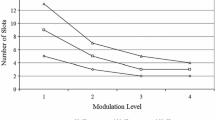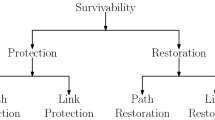Abstract
In this paper, we have developed an integrated online algorithm for dynamic routing of bandwidth guaranteed label switched paths (LSPs) in IP-over-WDM optical networks. Traditionally, routing at an upper layer (e.g., IP layer) is independent of wavelength routing at the optical layer. Wavelength routing at the optical layer sets up a quasi-static logical topology which is then used at the IP layer for IP routing. The coarse-grain wavelength channels and the pre-determined virtual topologies with respect to some a priori assumed traffic distribution are barriers to efficient resource use and inflexible to changing traffic. We take into account the combined knowledge of resource and topology information at both IP and optical layers. With this added knowledge, an integrated routing approach may extract better network efficiencies, be more robust to changing traffic patterns at the IP layer than schemes that either use dynamic routing information at the IP layer or use a static wavelength topology only. LSP set-up requests are represented in terms of a pair of ingress and egress routers as well as its bandwidth requirement, and arrive one-by-one. There is no a priori knowledge regarding the arrivals and characteristics of future LSP set-up requests. Our proposed algorithm considers not only the importance of critical links, but also their relative importance to routing potential future LSP set-up requests by characterizing their normalized bandwidth contribution to routing future LSP requests with bandwidth requirements. Moreover, link residual bandwidth information that captures the link's capability of routing future LSPs is also incorporated into route calculation. Extensive simulation was conducted to study the performance of our proposed algorithm and to compare it with some existing ones, such as the integrated minimum hop routing algorithm and the maximum open capacity routing algorithm. Simulation results show that our proposed algorithm performs better than both routing algorithms in terms of the number of LSP set-up requests rejected and the total available bandwidth between router pairs.
Similar content being viewed by others
References
B. Mukherjee, Optical communication networks (McGraw-Hill, 1997).
R. Ramaswami, K. N. Sivarajan, Optical networks: A practical perspective, Second ed. (Morgan Kaufmann Publisher, 2002).
C. S. R. Murthy, M. Gurusamy, WDM optical networks: Concepts, design, and algorithms (Prentice Hall PTR, 2002).
U. Black, Optical networks: Third generation transport systems (Prentice Hall PTR, 2002).
P. Green, Progress in optical networking, IEEE Communication Magazine, vol. 39,no. 1, (Jan. 2001), pp. 54-61.
B. Mukherjee, WDM optical networks: Progress and challenges, IEEE Journal of Selected Areas in Communications, vol. 18,no. 10, (Oct. 2000), pp. 1810-1824.
D. O. Awduche, et al., Multi-protocol lambda switching: Combining MPLS traffic engineering control with optical crossconnects, Work in progress, Internet Draft, draft-awduche-mpls-te-optical-02.txt, (July 2000).
B. Mack-Crane, et al., Enhancements to GMPLS signaling for optical technologies, Work in progress, Internet Draft, draft-mack-crane-gmpls-signaling-enhancements-00.txt, (Nov. 2000).
G. Bernstein, et al., Some comments on GMPLS and optical technologies, Work in progress, Internet Draft, draft-bernstein-gmpls-optical-00.txt, (Nov. 2000).
C. M. Assi, Y. Ye, A. A. Shami, I. Habib, M. A. Ali, Designing a survivable IP-over-WDM network, Proceedings of OptiComm, Denver, CO USA, (Aug. 2001), pp. 1-11.
B. Rajagopalan, et al., IP over optical networks: A framework, Work in progress, Internet Draft, draft-ietf-ipo-framework-02.txt, (June 2002).
P. Ashwood-Smith, et al., Generalized MPLS signaling—CR-LDP extensions, Work in progress, Internet Draft, draft-ietf-mpls-generalized-cr-ldp-06.txt, (April 2002).
G. Bernstein, et al., Optical inter domain routing considerations, Work in progress, Internet Draft, draft-ietf-ipo-optical-inter-domain-01.txt, (Feb. 2002).
E. Mannie, et al., Generalized multi-protocol label switching (GMPLS) architecture, Work in progress, Internet Draft, draft-ietf-ccamp-gmpls-architecture-02.txt, (March 2002).
K. Kompella, et al., OSPF Extensions in Support of Generalized MPLS, Work in progress, Internet Draft, draft-ietf-ccamp-ospf-gmpls-extensions-07.txt, (May 2002).
L. Berger, et al., Generalized MPLS—Signaling Functional Description, Work in progress, Internet Draft, draft-ietf-mpls-generalized-signaling-08.txt, (April 2002).
L. Berger, et al., Generalized MPLS signaling—RSVP-TE extensions, Work in progress, draft-ietf-mpls-generalized-rsvp-te-07.txt, (April 2002).
IETF MPLS Working Group. Multiprotocol label switching. http://www.ietf.org/html.charters /mpls-charter.html.
L. Anderson, et al., LDP specification. http://www.ietf.org/rfc/rfc3036.txt.
B. Jamoussi, et al., Constraint-based LSP setup using LDP. RFC 3212, (Jan. 2002).
P. Ashwood-Smith, et al., Generalized MPLS signaling—CR-LDP extensions, Work in progress, draft-ietf-mpls-generalized-cr-ldp-06.txt, (April 2002).
R. Braden, et al., Resource reservation protocol (RSVP)—version 1 functional specification. RFC 2205, (1997).
L. Burger, et al., Generalized MPLS signaling—RSVP-TE extensions. Work in progress, draft-ietf-mpls-generalized-rsvp-te-07.txt, (2002).
G. Malkin, RIP version 2: carrying additional information. RFC 1723, (1994).
R. Callon, Use of OSI IS-IS for routing in TCP/IP and dual environments. Request for Comments: 1195, (1990).
J. Moy, OSPF version 2. http://www.ietf.org/rfc/rfc2328.txt, 1998.
Y. Qin, B. Li, Architecture and analysis for providing virtual private networks (VPNs) with QoS over optical WDM networks, Optical Networks Magazine, vol. 2,no. 2, (March/April 2001), pp. 57-65.
B. Wang, J. C. Hou, Multicast routing and its QoS extension: Problem, algorithms, and protocols, IEEE Network, vol. 14,no. 1, (Jan./Feb. 2000), pp. 22-36.
R. Srinivasan, A. K. Somani, Request-specific routing in WDM grooming networks, Proceedings of IEEE International Conference on Communications (ICC 2002), New York City, NY, USA, (April–May 2002), vol. 5, pp. 2876-2880.
R. Srinivasan, Dynamic routing in WDM grooming networks, Iowa State University, Dept. of Electrical and Computer Engineering, DCNL Technical Report: DCNL-ON-2001-001, 2001.
S. Chen, K. Nahrstedt, An overview of quality of service routing for the next generation of high speed networks: problems and solutions, IEEE Network, vol. 12,no. 6, (Nov./Dec. 1998), pp. 64-79.
T. Li, H. Smit, IS-IS extensions for traffic engineering, Work in progress, Internet Draft, Draft-ietf-isis-traffic-04.txt, (Aug. 2001).
R. Guerin, D. Williams, A. Orda, QoS routing mechanisms and OSPF extensions, Proceedings of 2nd Global Internet Miniconference (joint with Globecom'97), Phoenix, AZ, (Nov. 1997). vol. 3, pp. 1903-1908
H. Y. Tyan, J. C. Hou, B. Wang, Many to many multicast routing with timing quality of service guarantees, To appear in IEEE Transactions on Computers, (2002).
H. Y. Tyan, J. C. Hou, B. Wang, QoS extension to core-based multicast routing, Accepted for publication in IEEE/ACM Transactions on Networking, (2002).
M. Kodialam, T. V. Lakshman, Minimum interference routing with applications to MPLS traffic engineering, Proceedings of INFOCOM, Tel-Aviv, Israel, (March 2000), vol. 1, pp. 884-893.
M. Kodialam, T. V. Lakshman, Integrated dynamic IP and wavelength routing in IP over WDM networks, Proceedings of INFOCOM, Anchorage, Alaska, USA, (April 2001) vol. 1, pp. 358-366.
B. Wang, X. Su, C. Chen, A new bandwidth guaranteed routing algorithm for MPLS traffic engineering, Proceedings of International Conference on Communications, New York City, NY, USA, (April–May 2002), vol. 2, pp. 1001-1005.
B. Rajagopalan, et al., IP over optical networks: A framework, Work in progress, Internet Draft, draft-ietf-ipo-framework-02.txt, (2002).
M. Kodialam, T. V. Lakshman, Dynamic routing of locally restorable bandwidth guaranteed tunnels using aggregated link usage information, Proceedings of INFOCOM, Anchorage, Alaska, USA, (April 2001), Vol. 1, pp. 376-385.
S. Thiagarajan, A. K. Somani, Traffic grooming for survivable WDM mesh networks, Proceedings of OptiComm, Denver, CO, USA, (August 2001), pp. 54-65.
C. Qiao, D. Xu, Distributed partial information management (DPIM) scheme for survivable networks — Part I, Proceedings of IEEE INFOCOM 2002, New York City, NY, USA, (June 2002), vol. 1, pp. 302-311.
S. Norden, M. M. Buddhikot, M. Waldvogel, S. Suri, Routing bandwidth guaranteed paths with restoration in label switched networks, Proceedings of ICNP, Riverside, CA, USA, (Nov. 2001), pp. 71-79.
O. Gerstel, G. H. Sasaki, Quality of protection (QoP): A quantitative unifying paradigm to protection service grades, Proceedings of OptiComm, Denver, CO, USA, (Aug. 2001), pp. 12-23.
C. Chen, S. Banerjee, A new model for optimal routing and wavelength assignment in wavelength division multiplexed optical networks. Proceedings of IEEE INFOCOM'96, San Francisco, CA, USA, (March 1996), vol. 1, pp. 164-171.
S. Suri, M. Waldvogel, P. Warkhede, Profile-based routing: A new framework for MPLS traffic engineering, Washington University Computer Science Technical Report WUCS-00-21, (July 2000).
A. Medina, C. Fraleigh, N. Taft, S. Bhattacharyya, C. Diot, Taxonomy of IP traffic matrices, Proceedings of Scalability and Traffic Control in IP Networks II, Boston, MA, USA, (July–Aug. 2002).
A. Medina, N. Taft, S. Bhattacharyya, C. Diot, Traffic matrix estimation: existing techniques and new directions, Proceedings of ACM SIGCOMM, Pittsburgh, PA, USA, (Aug. 2002), pp. 161-174.
M. Kodialam, T. V. Lakshman, Dynamic routing of bandwidth guaranteed tunnels with restoration, Proceedings of INFOCOM, Tel-Aviv, Israel, (March 2000), vol. 1, pp. 902-911.
Y. Liu, D. Tipper, P. Siripongwutikron, Approximating optimal spare capacity allocation by successive survivable routing, Proceedings of INFOCOM, Anchorage, Alaska, USA, (April 2001), vol. 2, pp. 699-708.
Y. Liu, D. Tipper, Successive survivable routing for node failures, Proceedings of IEEE GLOBECOM, San Antonio, TX, USA, (Nov. 2001), vol. 4, pp. 2093-2097.
O. Hauser, M. Kodialam, T. V. Lakshman, Capacity design of fast path restorable optical networks, Proceedings of INFOCOM, New York City, NY, USA, (June 2002), vol. 2, pp. 817-826.
E. Bouillet, J. Iabordette, G. Ellinas, R. Ramamurthy, S. Chaudhuri, Stochastic approaches to compute shared mesh restored lightpaths in optical network architectures, Proceedings of INFOCOM, New York City, NY, USA, (June 2002), vol. 2, pp. 801-807.
K. Kar, M. Kodialam, T. V. Lakshman, Routing restorable bandwidth guaranteed connections using maximum 2-route flows, Proceedings of INFOCOM, New York City, NY, USA, (June 2002), vol. 1, pp. 140-149.
G. Li, D. Wang, C. Kalmanek, R. Doverspike, Efficient distributed path selection for shared restoration connections, Proceedings of INFOCOM, New York City, NY, USA, (June 2002), Vol. 1, pp. 140-149.
J. Doucette, W. D. Grover, Capacity design studies of span-restorable mesh transport networks with shared-risk link group (SRLG) effects, Proceedings of OptiComm, Boston, MA, USA, (Aug. 2002), pp. 25-38.
M. Clouqueur, W. D. Grover, Mesh-restorable networks with complete dual failure restorability and with selectively enhanced dual-failure restorability properties, Proceedings of OptiComm, Boston, MA, USA, (Aug. 2002), pp. 1-12.
R. K. Ahuja, T. L. Magnanti, J. B. Orlin, Network flows: Theory, algorithms, and applications (Prentice Hall, 1993).
A. V. Goldberg, R. E. Tarjan, A new approach to the maximum-flow problem, Journal of the Association for Computing Machinery, vol. 35,no. 4, (Oct. 1988), pp. 921-940.
T. H. Cormen, C. E. Leiserson, R. L. Rivest, Introduction to algorithms (MIT Press, 1997).
D. S. Johnson, C. C. McGeoch, Solvers for the maximum flow problem in directed and undirected graphs. http://elib.zib.de/pub/Packages/mathprog/maxflow/, (1999).
E. Zegura, Georgia Tech internetwork topology models. http://www.cc.gatech.edu/fac/Ellen. Zegura/graphs.html.
Author information
Authors and Affiliations
Rights and permissions
About this article
Cite this article
Wang, B., Su, X. & Chen, C.L.P. A Bandwidth Guaranteed Integrated Routing Algorithm in IP over WDM Optical Networks. Photonic Network Communications 5, 227–245 (2003). https://doi.org/10.1023/A:1023088102754
Issue Date:
DOI: https://doi.org/10.1023/A:1023088102754




